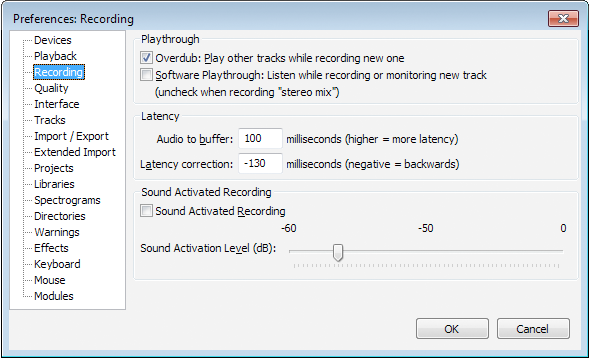Recording Preferences
From Audacity Manual

- Click on any of the other Preferences sections in the above image to go directly to that Preferences page.
Playthrough
- Overdub: Play other tracks while recording new one: Makes existing tracks in the project play when you hit Record. You can decide which tracks will play according to their mute/solo buttons.
- (Mac only) Hardware Playthrough: Listen while recording or monitoring new track: Allows you to hear the input by sending it directly to the output of the same audio device you are recording from. This incurs no latency or CPU usage, but may not work with all devices.
- Windows and Linux users can enable hardware playthrough by going to the operating system's mixer, then in the playback side, unmute and turn up the level of the input being used.
- Software Playthrough: Listen while recording or monitoring new track: Allows you to hear the input by sending it to any chosen playback device. This permits the recording and playback device to be different. Expect some latency in the sound that you hear, due to the time taken for the computer to process the audio. This option may cause recording dropouts on older, slower computers.
- Software Playthrough must not be used for recording computer playback because it will create feedback echoes.
- If you enable monitoring with either hardware or software playthrough, you can listen to the input without recording it.
- When recording from a microphone, listen in headphones so that the microphone picks up only what you are actually recording.
Latency
- Audio to buffer: At the default 100 milliseconds (ms) setting, the audio will take 0.1 seconds to travel through the sound card. Decreasing this value means recordings will be laid down on disk with less delay, and "software playthrough" may respond faster. However, the CPU will have to work harder as it is taking the audio through the sound card in smaller chunks. Setting this value too low (for example to 1 ms), will mean the CPU will not be able to keep up, and recording won't work. 100 ms is a safe setting for most computers.
- Latency correction: On most consumer systems there will be a delay between singing or hitting your note and it being laid down in the recording. When the default Overdub setting is enabled, Audacity will push recorded tracks backwards by 130 ms to compensate for this delay. If your latency is constant, you can adjust this correction value so that your recorded tracks should end up properly synchronized with the other tracks after correction. To set a custom latency value for your system, see the Latency Test page.
Sound Activated Recording
- Sound Activated Recording: Enables or disables Sound Activated Recording. When enabled, recording will automatically start or resume when the input volume rises above your chosen threshold level, and pause when the level falls below that threshold.
You cannot pause Sound Activated recordings manually using the Pause button or corresponding menu item or shortcut.
- Sound Activation Level (dB): Sets the threshold level in dB which triggers Sound Activated Recording. Although dB are logarithmic units, the actual scale values are displayed linearly (equally spaced for each value). The currently set dB value is displayed dynamically above the center of the scale.